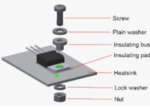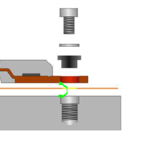hoyt
Newbie level 5

Hello:
I have a unit with a very thick aluminum box (earth grounded), which is used also as the heatsink. The transistor is a standard TO-220, running at line voltage (115Vac). The all-plastic style TO-220 was tried, but simply gets too hot (much worse thermal parameters than standard to-220). The TO-220 uses a large sil pad & shoulder washer & gets very warm/hot, but not "burning up".
So the unit is operating very fine.
However, even with a large area sil pad & big shoulder washer isn't something missing for creepage/clearance?
It seems to me that at the hole edge, the metal tab of the transistor is only a hair away from the metal of the housing (separated by the hair-thin thickness of the sil pad). Even with the shoulder washer, how does this provide enough creepage/clearance? So how do shoulder washers offer any help when this path still exists? The path from the tab to panel still exists on the outside of the smaller portion of the shoulder washer. I haven't seen this mentioned anywhere in terms of UL testing or anyone trying to resolve it...maybe not an issue?
I have a unit with a very thick aluminum box (earth grounded), which is used also as the heatsink. The transistor is a standard TO-220, running at line voltage (115Vac). The all-plastic style TO-220 was tried, but simply gets too hot (much worse thermal parameters than standard to-220). The TO-220 uses a large sil pad & shoulder washer & gets very warm/hot, but not "burning up".
So the unit is operating very fine.
However, even with a large area sil pad & big shoulder washer isn't something missing for creepage/clearance?
It seems to me that at the hole edge, the metal tab of the transistor is only a hair away from the metal of the housing (separated by the hair-thin thickness of the sil pad). Even with the shoulder washer, how does this provide enough creepage/clearance? So how do shoulder washers offer any help when this path still exists? The path from the tab to panel still exists on the outside of the smaller portion of the shoulder washer. I haven't seen this mentioned anywhere in terms of UL testing or anyone trying to resolve it...maybe not an issue?




